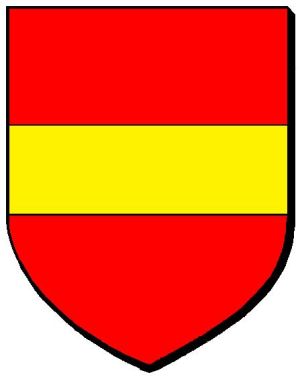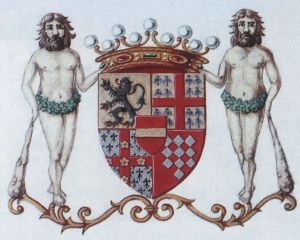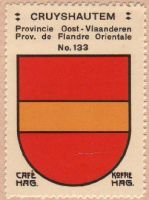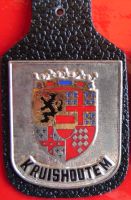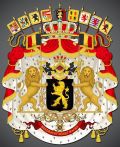Kruishoutem: Difference between revisions
Knorrepoes (talk | contribs) m (Text replacement - "{{media1}}" to "{{media}}") |
Knorrepoes (talk | contribs) m (Text replacement - "{{be1}}" to "{{be}}") |
||
| Line 44: | Line 44: | ||
[[Civic Heraldry Literature - Belgium|'''Literature''']]: Servais, 1955 | [[Civic Heraldry Literature - Belgium|'''Literature''']]: Servais, 1955 | ||
{{ | {{be}} | ||
{{media}} | {{media}} | ||
Revision as of 09:14, 29 August 2023
|
Country : Belgium Province : Oost-Vlaanderen Additions :
Incorporated into :
|
| Dutch |
|
| English | blazon wanted |
Origin/meaning
The arms were granted on July 31, 1935 and augmented and with added supporters on February 3, 1950 and again on July 31, 1978.
The original arms from 1935 show the arms of the Jauche family as Lords of Kruishoutem. The arms were a simplification of the seal of the council from 1626 which showed the full arms used at the time. These full arms were granted in 1950 and confirmed in 1978.
The full arms are a combination of the following elements :
The first quarter shows the lion of Vlaanderen, the second the arms of the family Montmorency, the third the arms of the family Sainte Aldegon de Noircarme and the fourth the arms of the Lalaing family and finally an escutcheon with the arms of the Jauche family. These complicated arms were the arms of Philippe de Jauche, Lord of Kruishoutem in the early 17th century. He was the grandson of Josien van Vlaanderen and Jeanne de Montmorency-Croisilles and the son of Anna de Sainte Aldegon de Noircarme, which explains the arms.
The arms in the Koffie Hag/Café Hag albums +/- 1930
The arms on a police badge (source)
Literature: Servais, 1955
Belgium heraldry portal
This page is part of the Belgium heraldry portal |
Heraldry of the World |
|
Civic heraldry:
|
Other heraldry: |
Contact and Support
Partners:
Your logo here ?
Contact us
© since 1995, Heraldry of the World, Ralf Hartemink 
Index of the site
